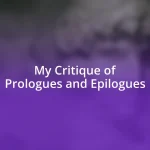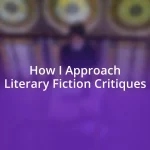Key takeaways:
- Unreliable narrators prompt readers to question truth and perception by showcasing complex character motivations and selective storytelling techniques.
- Recognizing narrative techniques like selective memory and ambiguity enhances the reading experience, encouraging active engagement rather than passive absorption of the text.
- Developing critical reading skills through introspective empathy, curiosity, and collaborative discussions deepens understanding of unreliable narratives and their multifaceted truths.
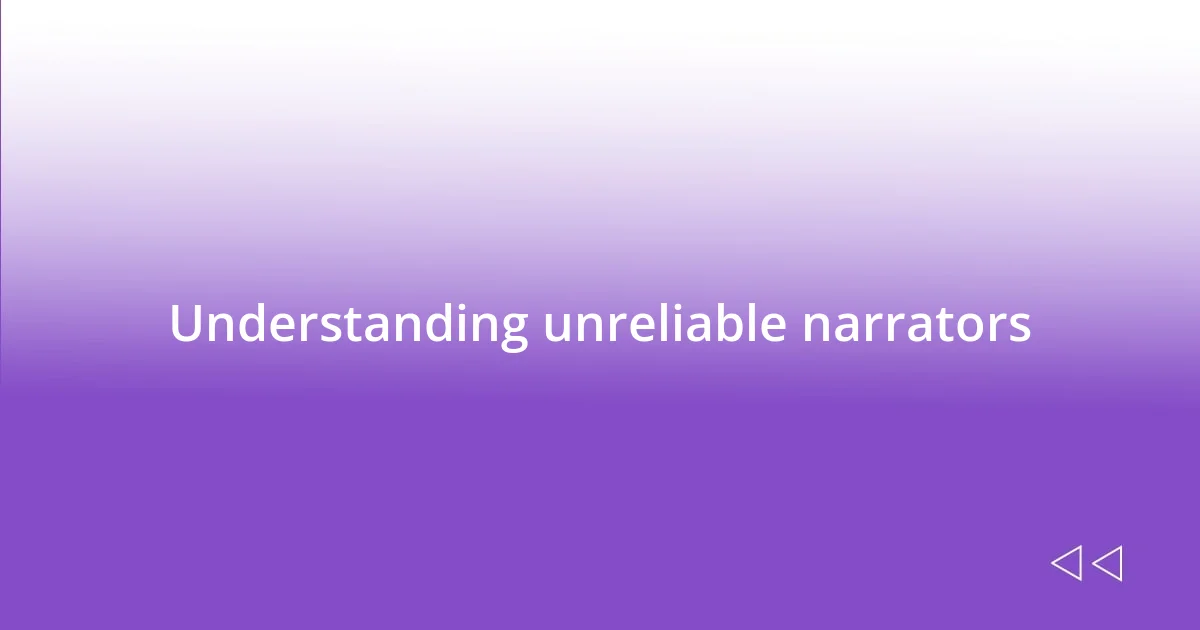
Understanding unreliable narrators
Unreliable narrators can be fascinating because they challenge our perceptions and force us to question everything we read. For instance, I recall a time when I picked up a novel with a seemingly straightforward plot, only to discover that each twist and reveal reshaped my understanding of the protagonist’s motives. Isn’t it intriguing how our trust can shift so dramatically based on a character’s perspective?
These narrators often weave a complex tapestry of truth and deception, reflecting the multifaceted nature of human experience. I’ve often found myself contemplating why we are drawn to these flawed voices. Perhaps it’s because they mirror our own struggles with perspective and the very essence of truth.
Engaging with unreliable narrators can feel like embarking on a treasure hunt. The thrill lies in piecing together the fragments of their narrative, searching for clues that might lead to a deeper understanding. I once immersed myself in a story where the narrator’s selective memory transformed the mundane into the extraordinary, leaving me to ponder: how much of what we perceive is shaped by our biases and memories? It’s an eye-opening exploration that resonates long after the last page is turned.
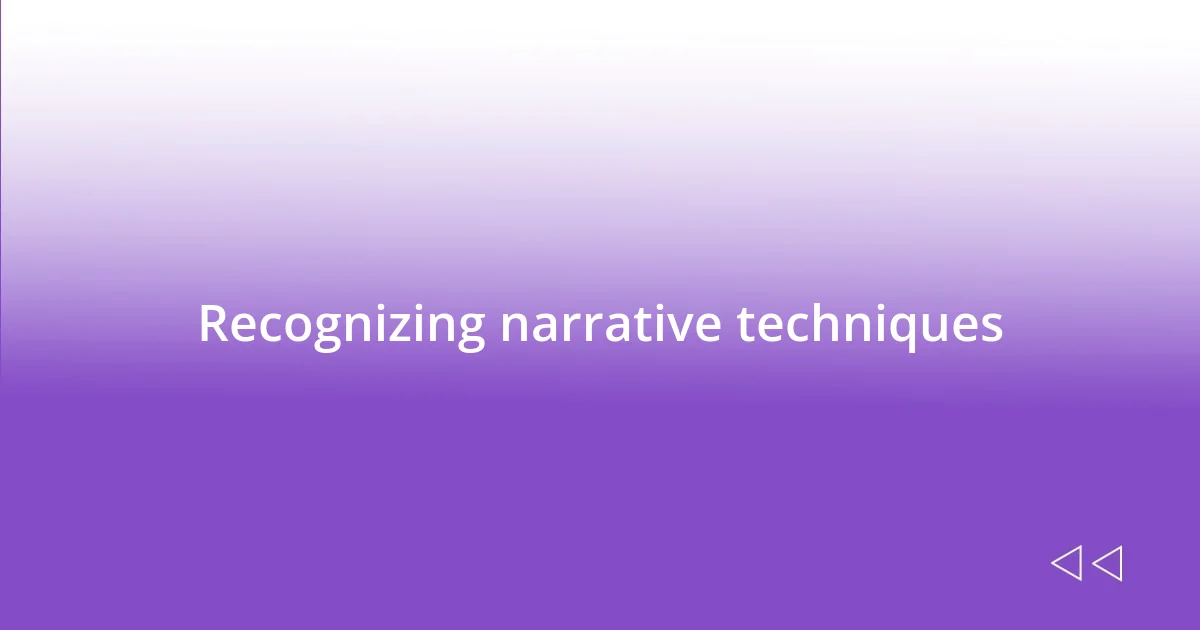
Recognizing narrative techniques
When exploring narrative techniques in unreliable narrators, I often find myself attuned to their subtle nuances. For example, I remember reading a novel where the narrator would strategically omit details that changed the story’s context entirely. It made me realize how I could be manipulated by what was left unsaid and how it amplified the suspense. This intentional use of omission is especially powerful, prompting me to reassess the information I take at face value.
Key narrative techniques to recognize in unreliable narrators include:
- Selective Memory: Distortion of events based on emotional bias, influencing the reader’s perception.
- Inconsistency: Contradictory statements that force readers to question the narrator’s reliability.
- Foreshadowing: Hints embedded in the narrative that may lead to a twist or reveal.
- Ambiguity: Deliberate vagueness that opens multiple interpretations and invites skepticism.
- Fragmented Storytelling: Non-linear timelines that reflect the chaotic nature of memory and perspective.
In my experience, these techniques create a sense of unease that compels me to dig deeper and reconsider what I thought I knew. I’ve found that recognizing these literary devices enhances my reading journey, transforming it into an interactive experience rather than passively absorbing information.
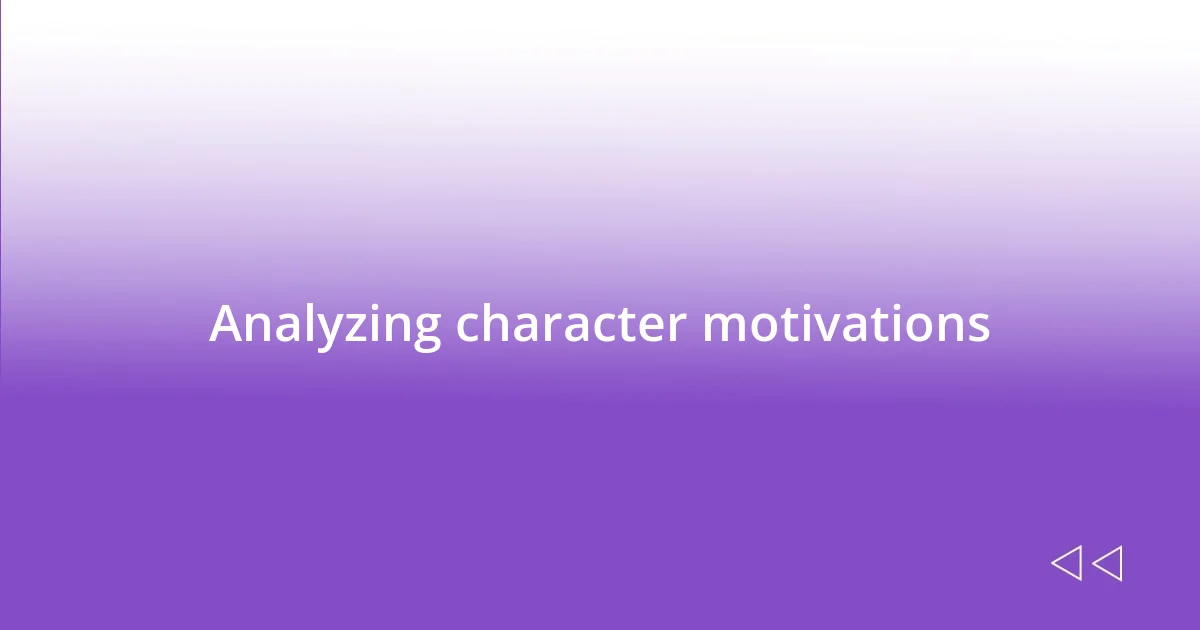
Analyzing character motivations
Analyzing character motivations is crucial when engaging with unreliable narrators. I’ve often found that understanding what drives a character can completely reshape my interpretation of their actions. One memorable experience was when I read a novel where the narrator’s motivations revealed a deep-seated fear of abandonment. This detail not only made me reconsider their seemingly erratic behavior but also allowed me to empathize with their situation, making the story resonate on a more profound level.
On another occasion, I encountered a narrator who was motivated by a desire for recognition. Their embellishments and exaggerations painted a vivid picture but also raised questions about authenticity. I began to reflect on my own experiences with self-presentation, connecting with the narrator’s longing for approval. Such motivations can mask deeper emotions and insecurities, providing layers to their unreliable nature that I find utterly captivating.
When I look at character motivations, I often create a mental checklist. Asking myself questions like, “What do they want? What fears drive them?” allows me to peel back layers of their narrative. Engaging in this practice not only enhances my understanding of the story but also enriches my reading experience, turning the act of reading into an active exploration of the human psyche.
| Motivation Type | Example |
|---|---|
| Fear of Abandonment | Narrator’s erratic behavior stems from childhood trauma |
| Desire for Recognition | Narrator exaggerates to gain the admiration of others |
| Need for Control | Narrator manipulates events to maintain a sense of power |
| Guilt or Regret | Narrator’s actions are clouded by unresolved past mistakes |
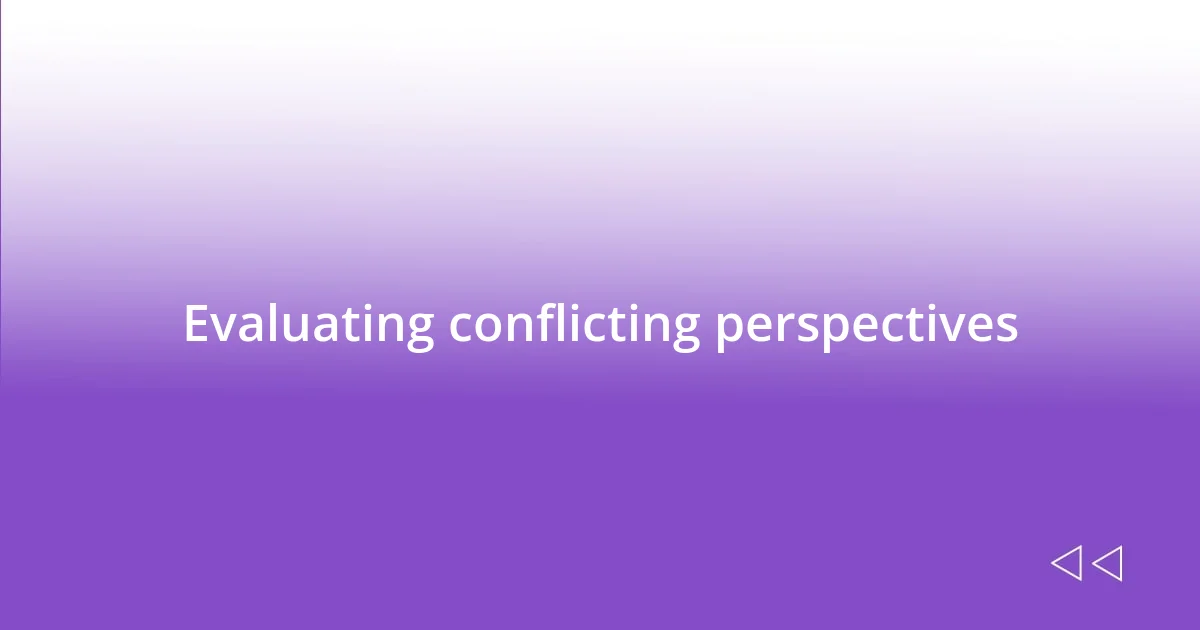
Evaluating conflicting perspectives
When evaluating conflicting perspectives, I often find myself wrestling with my own biases. For instance, I remember a time reading a novel where two characters had entirely different versions of a shared event. Each perspective seemed so credible that it made me question my own judgments about truth. How often do we allow our preconceptions to distort our understanding of a situation? It’s a reminder that the complexity of human experience can lead to vastly different interpretations, prompting me to be more open-minded.
I actively compare the details presented by each narrator. I recall a specific instance where I felt torn between believing one narrator’s emotional plea and the rigid structure of another’s logical account. This tug-of-war made me realize that emotions can often cloud rational thinking, leading to significant misinterpretations. Has this ever happened to you? In my view, it’s essential to remain skeptical of each perspective, weighing their merits while acknowledging the influence of personal feelings on their claims.
Understanding conflicting perspectives also means recognizing the context in which these narratives unfold. There was a story where a narrator framed their friendships in a negative light, painting others as villains while portraying themselves as the victim. Reflecting on this, I questioned how much context shapes our perceptions of people. It reinforced my belief that our connections with others are often more intricate than they first appear, making it crucial to evaluate the motivations and backgrounds that inform each viewpoint. What a fascinating puzzle it becomes when you breathe deeper into layers of narrative!
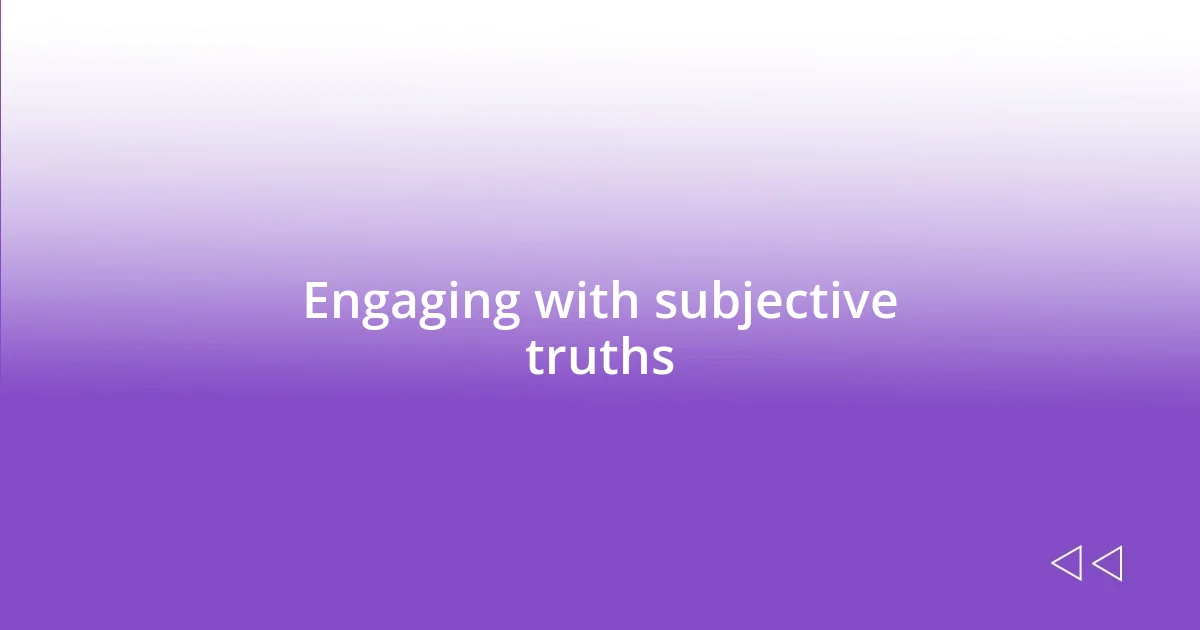
Engaging with subjective truths
Engaging with subjective truths invites me to reflect on how personal experiences shape our understanding of situations. I remember analyzing a documentary that featured individuals recounting a traumatic event. Each person’s retelling revealed not just varying facts but also how their emotions colored their memories. Have you ever noticed how your feelings about a past event shift the details in your mind? It’s a powerful reminder that what we perceive as truth is often layered with personal bias and emotional depth.
I find that tracing these subjective truths often leads me to consider my own biases as well. A few years back, I read a book that challenged my views on an ethically ambiguous character. At first, I deemed them selfish; however, as I delved deeper into their backstory, I discovered a longing for acceptance that resonated with my own struggles. It’s intriguing how understanding a character’s subjective truth can shift our feelings entirely. How might our interpretations of individuals change if we embraced their emotional narratives?
This journey into subjective truths doesn’t merely stop at understanding characters; it expands into how we view the world around us. I recently observed a friend share a heartfelt story that seemed contrary to facts I knew. The intensity of their emotions prompted me to step back and consider—what’s more important, the objective facts or the subjective experiences? It’s moments like these that inspire me to engage with others’ narratives more compassionately, understanding that beneath every story lies a multitude of subjective truths waiting to be explored.
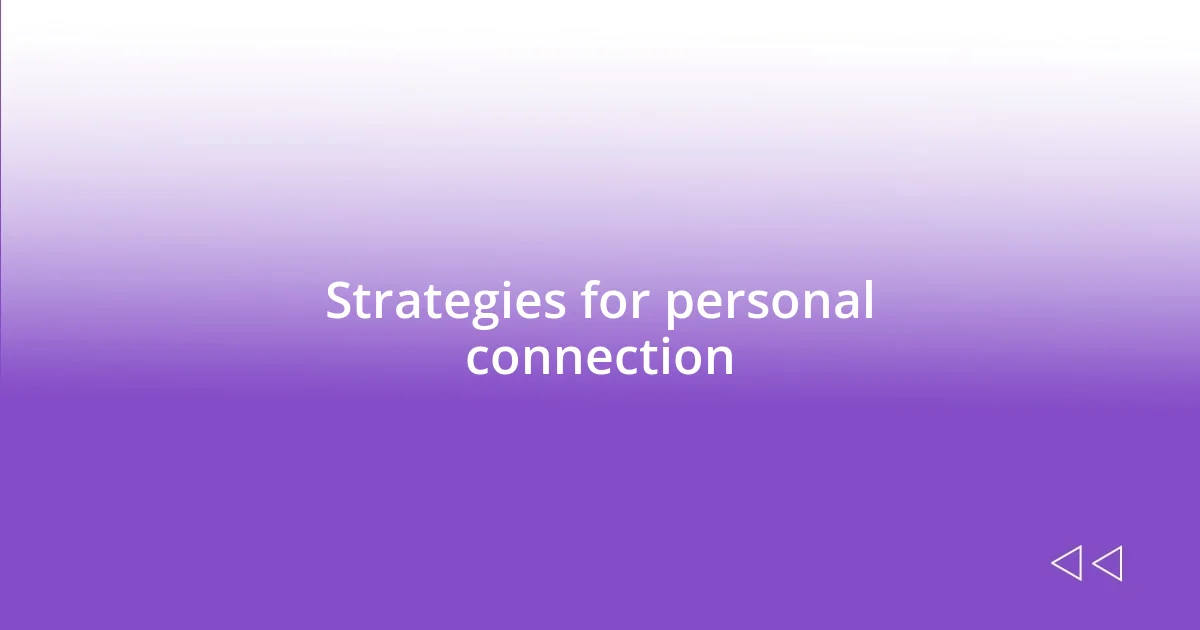
Strategies for personal connection
One of the strategies I often utilize for a personal connection with unreliable narrators involves introspective empathy. I recall a book where the unreliable narrator struggled with addiction. As I followed their journey, I found myself connecting with their vulnerabilities; it evoked memories of my own challenges with self-doubt. This experience led me to ask: how much of our understanding hinges on the emotional resonance we feel with a character? It’s a reminder that even flawed narratives can prompt profound emotional connections.
Another approach I’ve adopted is to seek commonalities in experiences. For instance, while reading a novel featuring a narrator who consistently distorted facts, I recognized parallels between their fear of rejection and a moment in my life when I felt similarly vulnerable. This connection encouraged me to ponder, can we find strength in someone else’s struggle, even if their perspective feels skewed? I believe I can unlock deeper insights by bridging these emotional gaps and recognizing that each character’s journey often mirrors our own in some way.
Lastly, I try to keep a curious mindset, treating the narrative as a puzzle waiting to be solved. I think back to a short story that kept me guessing about who was truly trustworthy. With every twist and turn, I engaged with the text like I was part of a thrilling mystery. This playful attitude not only increased my engagement but also deepened my understanding of the narrator’s motives. Have you ever approached a story this way? I’ve found that embracing curiosity allows me to explore unreliable narratives, transforming potential frustration into an enriching adventure.
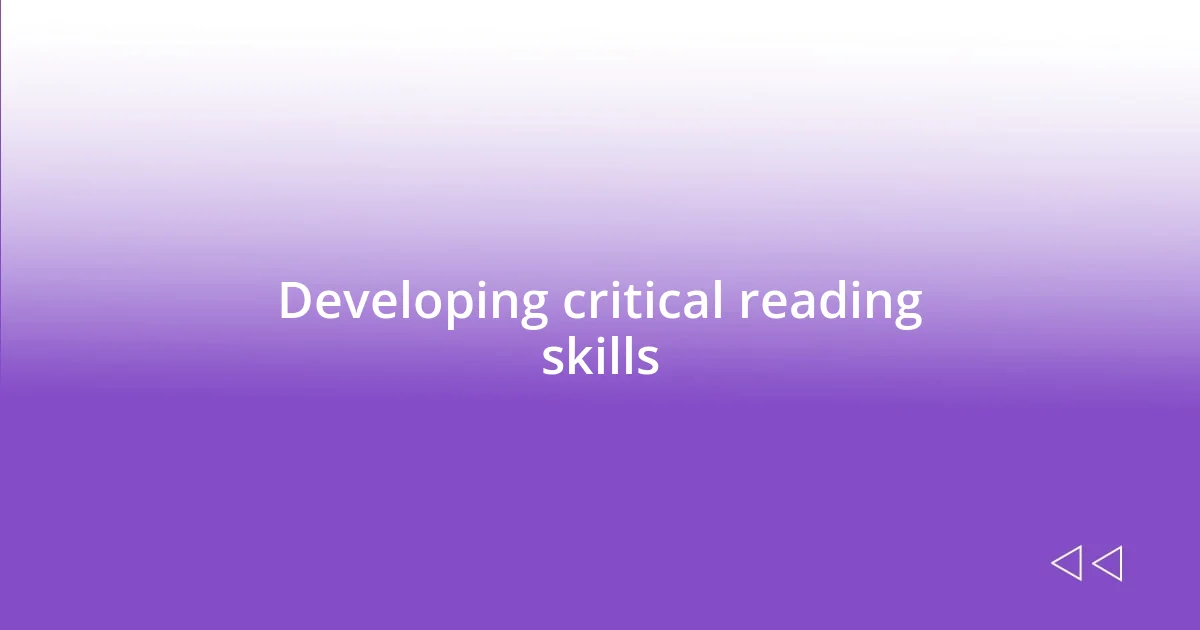
Developing critical reading skills
Developing critical reading skills is essential when navigating the complex tapestry woven by unreliable narrators. I remember a time when I tackled a novel with a seemingly transparent narrator who turned out to be anything but. Engaging with their perspective meant dissecting their motivations and questioning their interpretations of events. This experience made me realize how crucial it is to approach such narratives with both skepticism and openness. How often do we take narrators at face value, missing out on deeper layers of meaning?
As I honed my critical reading skills, I discovered the importance of annotating passages that made me pause. I once read a short story where the narrator’s inconsistencies created a rich dialogue within my own thoughts. Each time I jotted down a question or drew a connection, I felt an exhilarating sense of discovery. What if I had ignored those moments of confusion? It’s these notes that often reveal the most profound insights about the text and the narrator’s layered psyche.
Additionally, discussing literature with others can significantly enhance my understanding. I vividly recall a book club meeting where we dissected a particularly unreliable narrator. As we voiced our interpretations, I found that listening to different viewpoints illuminated aspects I hadn’t considered. It’s fascinating how collective discussions can enrich our reading experience, helping me develop a more nuanced understanding of unreliable narratives. Have you ever had a conversation that completely reshaped your perspective on a story? That shared exploration can transform how we read and interpret unreliable narrators, turning skepticism into a collaborative journey.
